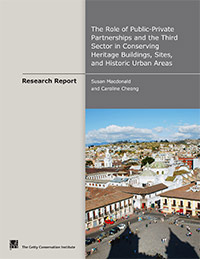The Role of Public-Private Partnerships and the Third Sector in Conserving Heritage Buildings, Sites, and Historic Urban Areas

|
|
The conservation of cultural heritage requires the involvement of multiple actors from across the public, private, and nongovernment sectors, both to carry out conservation work and to sustain the heritage place in the long term. Conservation of the historic urban environment is particularly challenging, as conservation actions must be embedded within wider economic, social, and environmental development strategies. Increasingly, the private and nongovernment sectors are playing pivotal roles in urban heritage conservation through public-private partnership mechanisms.
This publication is directed toward those working in the cultural heritage sector. While it is not a guide to the use of public-private partnerships (PPPs), it aims to foster an understanding of their underlying concepts and demonstrate how and where they have been used to create successful heritage conservation outcomes. Case studies are used to illustrate various PPP types, the roles and responsibilities of partners, and how PPPs have met conservation goals for a range of heritage places, from individual buildings to historic urban areas.
This publication is also intended as a resource for those seeking to advance research in this field; it provides an extensive bibliography of general texts on PPPs, as well as those specific to PPPs in the historic urban environment.
Related project: Historic Cities and Urban Settlements Initiative
Related project: Historic Cities and Urban Settlements Initiative
How to Cite this Work
Macdonald, Susan, and Caroline Cheong. 2014. The Role of Public-Private Partnerships and the Third Sector in Conserving Heritage Buildings, Sites, and Historic Urban Areas. Los Angeles, CA: Getty Conservation Institute.
http://hdl.handle.net/10020/gci_pubs/public_private_partnerships
Macdonald, Susan, and Caroline Cheong. 2014. The Role of Public-Private Partnerships and the Third Sector in Conserving Heritage Buildings, Sites, and Historic Urban Areas. Los Angeles, CA: Getty Conservation Institute.
http://hdl.handle.net/10020/gci_pubs/public_private_partnerships
|
|||||||||||||||||||||||||||||||||||